MGT8033 - Leading Organizational Change: Case Study Analysis Report
VerifiedAdded on 2022/09/28
|12
|2903
|20
Report
AI Summary
This report presents a comprehensive analysis of a case study focusing on leading organizational change within the context of Site Security and Secure Escorts (SSSE). The analysis begins by comparing and contrasting the relationship between change readiness and change agents, drawing upon the case study to illustrate these concepts. It examines organizational diagnosis, employee perspectives, and the roles of change agents in fostering readiness. The report then delves into Kotter’s Integrative model of organizational dynamics, outlining its components and their application to the case study. Finally, it explores appropriate leadership approaches and competencies necessary for implementing change at SSSE, emphasizing the importance of leadership in motivating employees, redesigning jobs, and aligning organizational policies. The report utilizes academic sources and the case study to support its arguments, providing insights into effective change management strategies.
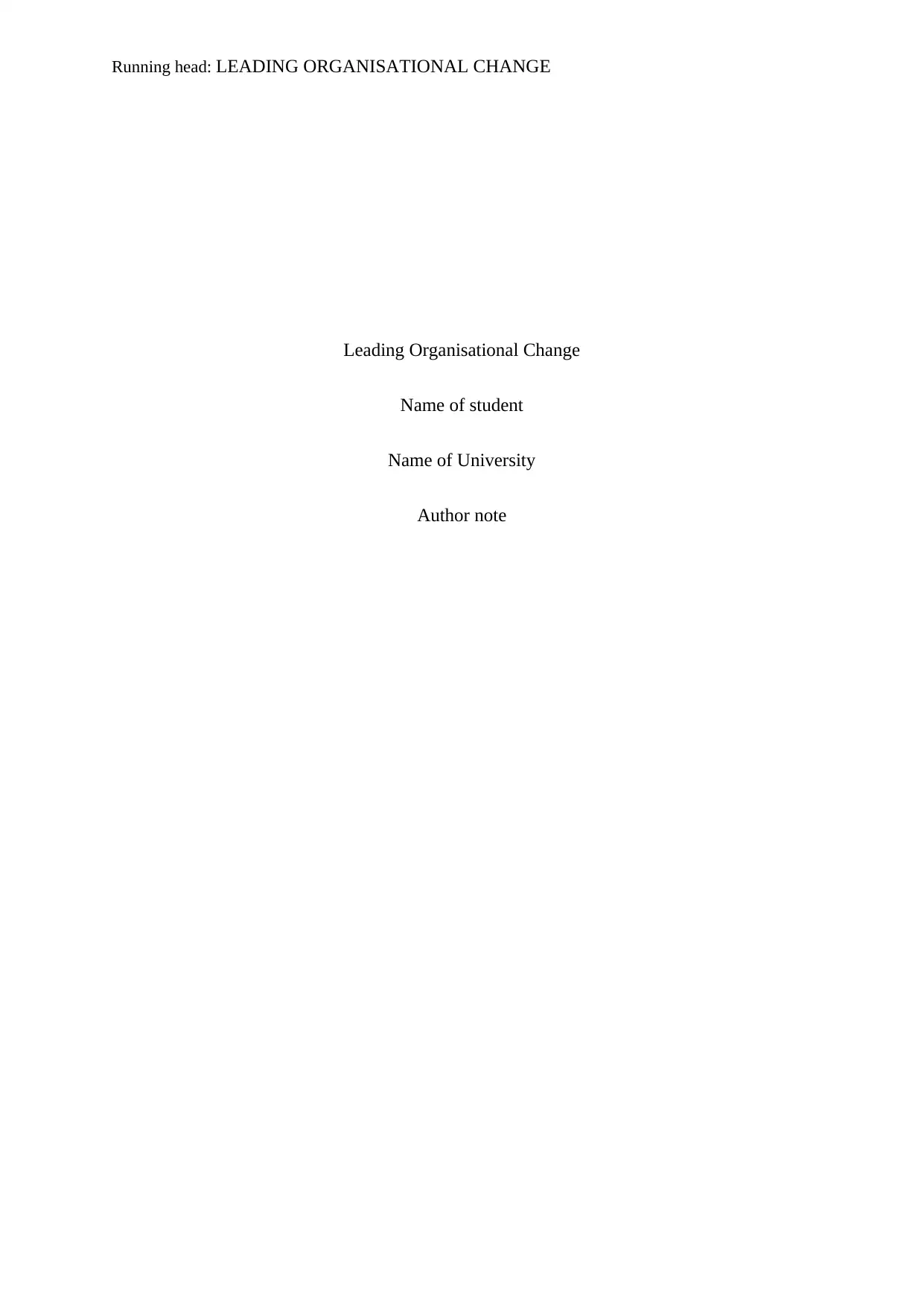
Running head: LEADING ORGANISATIONAL CHANGE
Leading Organisational Change
Name of student
Name of University
Author note
Leading Organisational Change
Name of student
Name of University
Author note
Paraphrase This Document
Need a fresh take? Get an instant paraphrase of this document with our AI Paraphraser
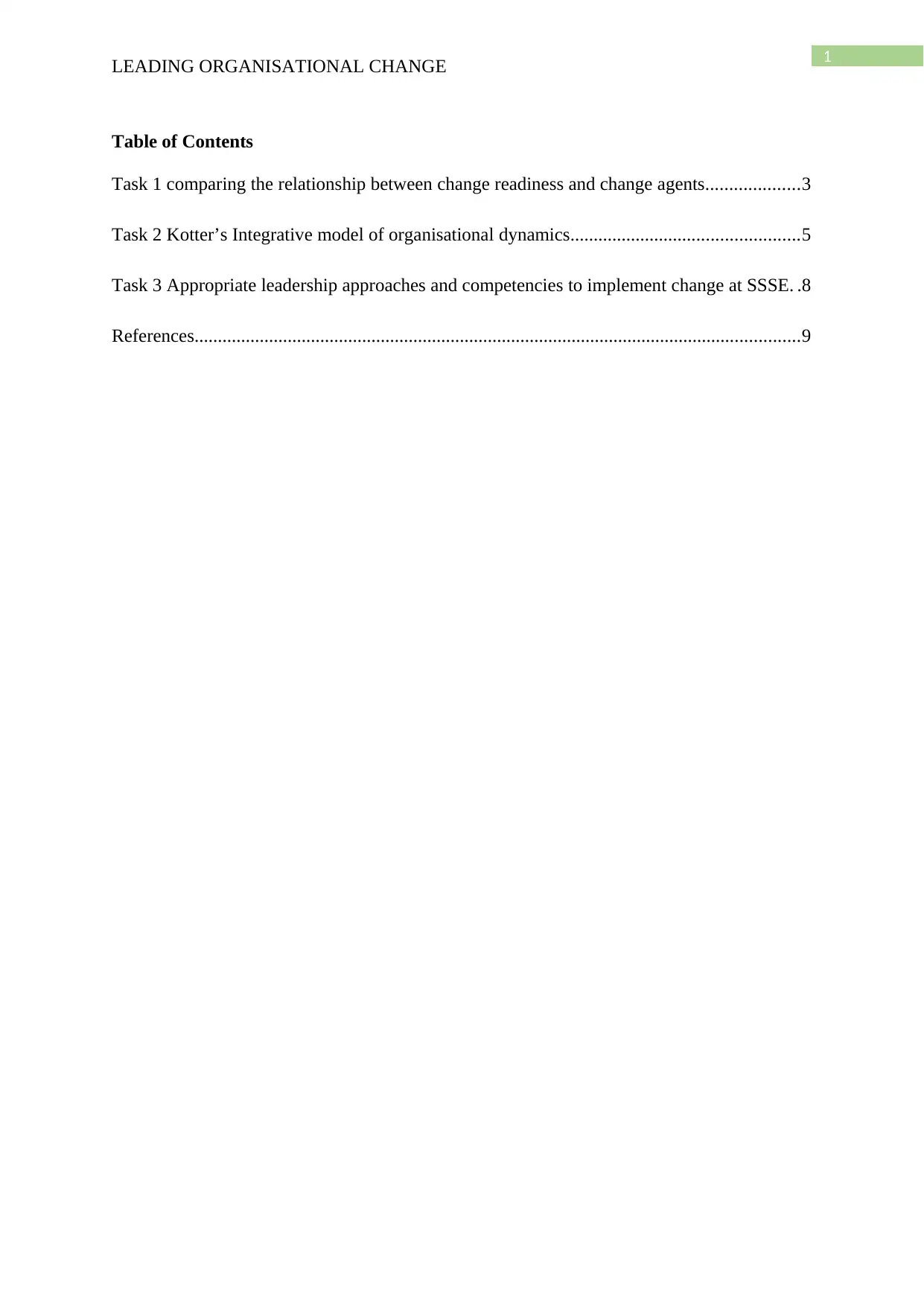
1
LEADING ORGANISATIONAL CHANGE
Table of Contents
Task 1 comparing the relationship between change readiness and change agents....................3
Task 2 Kotter’s Integrative model of organisational dynamics.................................................5
Task 3 Appropriate leadership approaches and competencies to implement change at SSSE. .8
References..................................................................................................................................9
LEADING ORGANISATIONAL CHANGE
Table of Contents
Task 1 comparing the relationship between change readiness and change agents....................3
Task 2 Kotter’s Integrative model of organisational dynamics.................................................5
Task 3 Appropriate leadership approaches and competencies to implement change at SSSE. .8
References..................................................................................................................................9
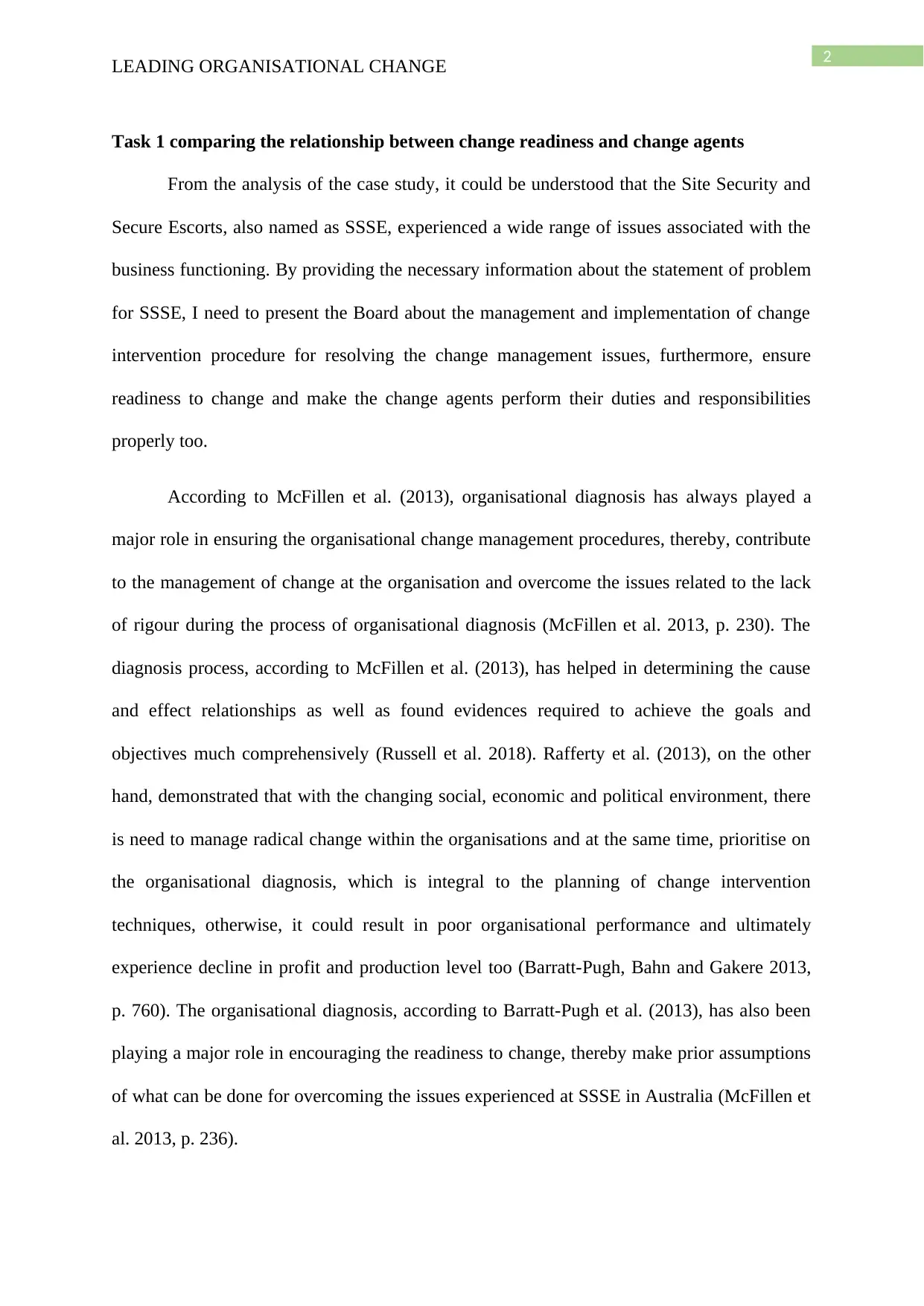
2
LEADING ORGANISATIONAL CHANGE
Task 1 comparing the relationship between change readiness and change agents
From the analysis of the case study, it could be understood that the Site Security and
Secure Escorts, also named as SSSE, experienced a wide range of issues associated with the
business functioning. By providing the necessary information about the statement of problem
for SSSE, I need to present the Board about the management and implementation of change
intervention procedure for resolving the change management issues, furthermore, ensure
readiness to change and make the change agents perform their duties and responsibilities
properly too.
According to McFillen et al. (2013), organisational diagnosis has always played a
major role in ensuring the organisational change management procedures, thereby, contribute
to the management of change at the organisation and overcome the issues related to the lack
of rigour during the process of organisational diagnosis (McFillen et al. 2013, p. 230). The
diagnosis process, according to McFillen et al. (2013), has helped in determining the cause
and effect relationships as well as found evidences required to achieve the goals and
objectives much comprehensively (Russell et al. 2018). Rafferty et al. (2013), on the other
hand, demonstrated that with the changing social, economic and political environment, there
is need to manage radical change within the organisations and at the same time, prioritise on
the organisational diagnosis, which is integral to the planning of change intervention
techniques, otherwise, it could result in poor organisational performance and ultimately
experience decline in profit and production level too (Barratt-Pugh, Bahn and Gakere 2013,
p. 760). The organisational diagnosis, according to Barratt-Pugh et al. (2013), has also been
playing a major role in encouraging the readiness to change, thereby make prior assumptions
of what can be done for overcoming the issues experienced at SSSE in Australia (McFillen et
al. 2013, p. 236).
LEADING ORGANISATIONAL CHANGE
Task 1 comparing the relationship between change readiness and change agents
From the analysis of the case study, it could be understood that the Site Security and
Secure Escorts, also named as SSSE, experienced a wide range of issues associated with the
business functioning. By providing the necessary information about the statement of problem
for SSSE, I need to present the Board about the management and implementation of change
intervention procedure for resolving the change management issues, furthermore, ensure
readiness to change and make the change agents perform their duties and responsibilities
properly too.
According to McFillen et al. (2013), organisational diagnosis has always played a
major role in ensuring the organisational change management procedures, thereby, contribute
to the management of change at the organisation and overcome the issues related to the lack
of rigour during the process of organisational diagnosis (McFillen et al. 2013, p. 230). The
diagnosis process, according to McFillen et al. (2013), has helped in determining the cause
and effect relationships as well as found evidences required to achieve the goals and
objectives much comprehensively (Russell et al. 2018). Rafferty et al. (2013), on the other
hand, demonstrated that with the changing social, economic and political environment, there
is need to manage radical change within the organisations and at the same time, prioritise on
the organisational diagnosis, which is integral to the planning of change intervention
techniques, otherwise, it could result in poor organisational performance and ultimately
experience decline in profit and production level too (Barratt-Pugh, Bahn and Gakere 2013,
p. 760). The organisational diagnosis, according to Barratt-Pugh et al. (2013), has also been
playing a major role in encouraging the readiness to change, thereby make prior assumptions
of what can be done for overcoming the issues experienced at SSSE in Australia (McFillen et
al. 2013, p. 236).
⊘ This is a preview!⊘
Do you want full access?
Subscribe today to unlock all pages.

Trusted by 1+ million students worldwide
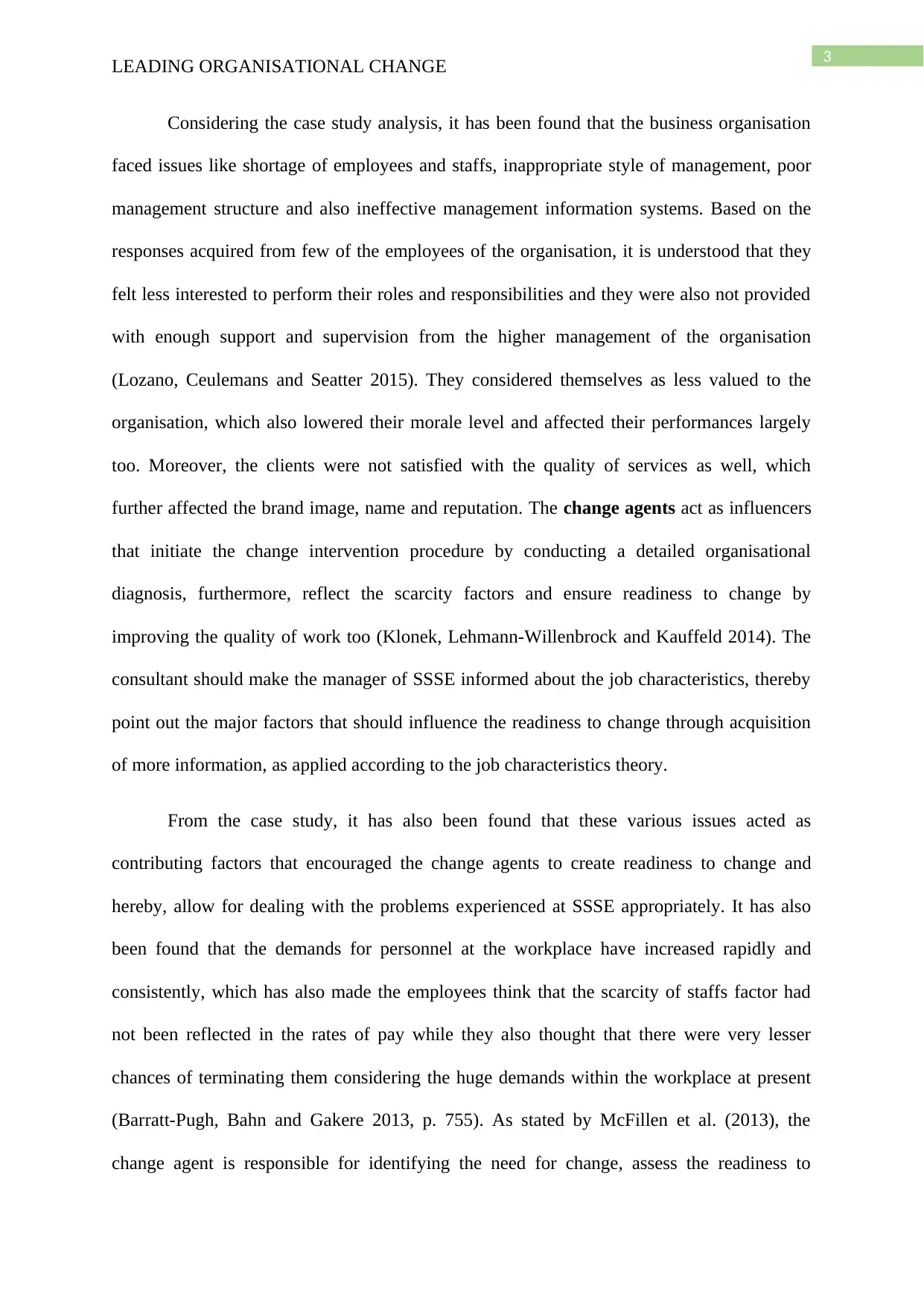
3
LEADING ORGANISATIONAL CHANGE
Considering the case study analysis, it has been found that the business organisation
faced issues like shortage of employees and staffs, inappropriate style of management, poor
management structure and also ineffective management information systems. Based on the
responses acquired from few of the employees of the organisation, it is understood that they
felt less interested to perform their roles and responsibilities and they were also not provided
with enough support and supervision from the higher management of the organisation
(Lozano, Ceulemans and Seatter 2015). They considered themselves as less valued to the
organisation, which also lowered their morale level and affected their performances largely
too. Moreover, the clients were not satisfied with the quality of services as well, which
further affected the brand image, name and reputation. The change agents act as influencers
that initiate the change intervention procedure by conducting a detailed organisational
diagnosis, furthermore, reflect the scarcity factors and ensure readiness to change by
improving the quality of work too (Klonek, Lehmann-Willenbrock and Kauffeld 2014). The
consultant should make the manager of SSSE informed about the job characteristics, thereby
point out the major factors that should influence the readiness to change through acquisition
of more information, as applied according to the job characteristics theory.
From the case study, it has also been found that these various issues acted as
contributing factors that encouraged the change agents to create readiness to change and
hereby, allow for dealing with the problems experienced at SSSE appropriately. It has also
been found that the demands for personnel at the workplace have increased rapidly and
consistently, which has also made the employees think that the scarcity of staffs factor had
not been reflected in the rates of pay while they also thought that there were very lesser
chances of terminating them considering the huge demands within the workplace at present
(Barratt-Pugh, Bahn and Gakere 2013, p. 755). As stated by McFillen et al. (2013), the
change agent is responsible for identifying the need for change, assess the readiness to
LEADING ORGANISATIONAL CHANGE
Considering the case study analysis, it has been found that the business organisation
faced issues like shortage of employees and staffs, inappropriate style of management, poor
management structure and also ineffective management information systems. Based on the
responses acquired from few of the employees of the organisation, it is understood that they
felt less interested to perform their roles and responsibilities and they were also not provided
with enough support and supervision from the higher management of the organisation
(Lozano, Ceulemans and Seatter 2015). They considered themselves as less valued to the
organisation, which also lowered their morale level and affected their performances largely
too. Moreover, the clients were not satisfied with the quality of services as well, which
further affected the brand image, name and reputation. The change agents act as influencers
that initiate the change intervention procedure by conducting a detailed organisational
diagnosis, furthermore, reflect the scarcity factors and ensure readiness to change by
improving the quality of work too (Klonek, Lehmann-Willenbrock and Kauffeld 2014). The
consultant should make the manager of SSSE informed about the job characteristics, thereby
point out the major factors that should influence the readiness to change through acquisition
of more information, as applied according to the job characteristics theory.
From the case study, it has also been found that these various issues acted as
contributing factors that encouraged the change agents to create readiness to change and
hereby, allow for dealing with the problems experienced at SSSE appropriately. It has also
been found that the demands for personnel at the workplace have increased rapidly and
consistently, which has also made the employees think that the scarcity of staffs factor had
not been reflected in the rates of pay while they also thought that there were very lesser
chances of terminating them considering the huge demands within the workplace at present
(Barratt-Pugh, Bahn and Gakere 2013, p. 755). As stated by McFillen et al. (2013), the
change agent is responsible for identifying the need for change, assess the readiness to
Paraphrase This Document
Need a fresh take? Get an instant paraphrase of this document with our AI Paraphraser
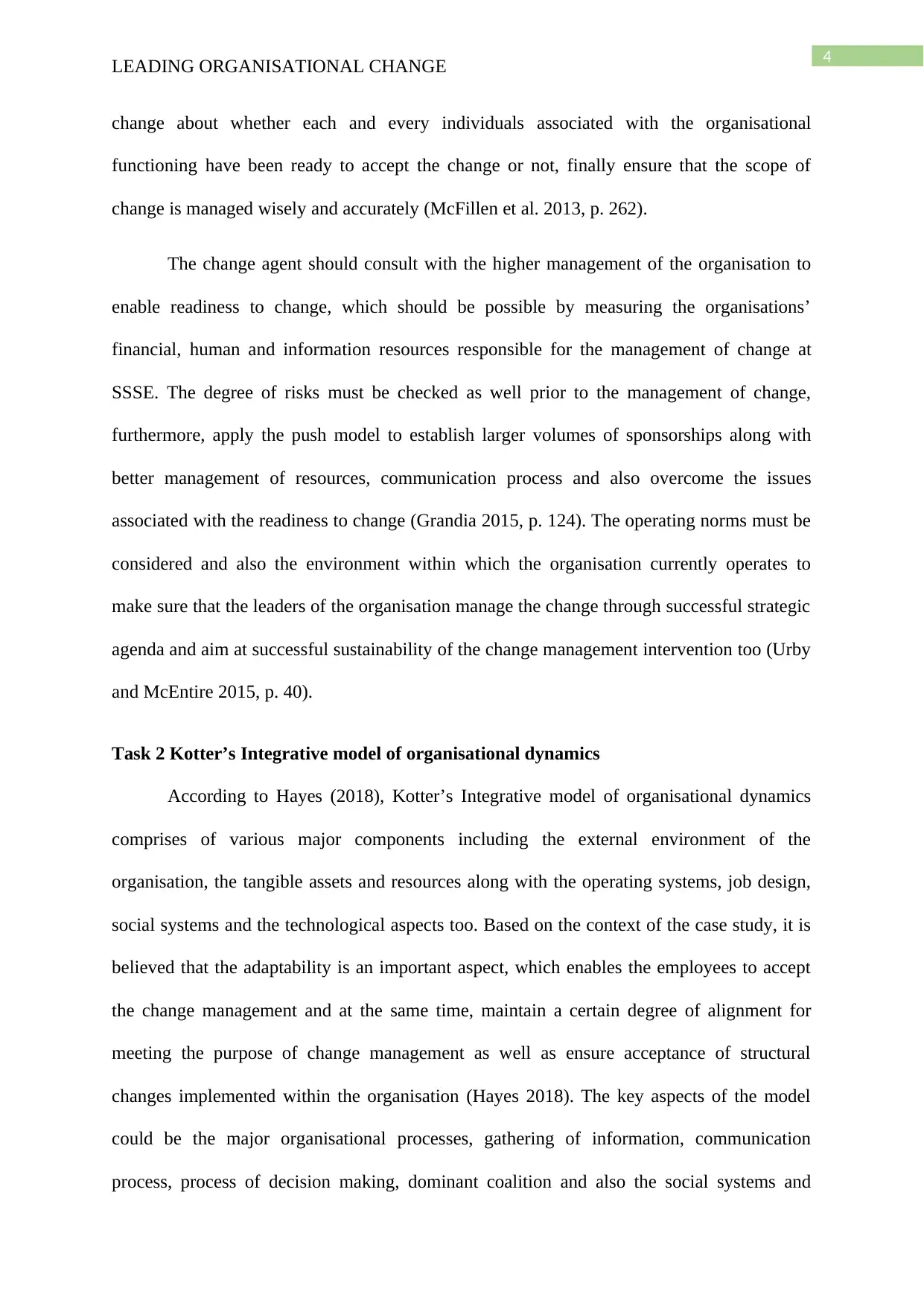
4
LEADING ORGANISATIONAL CHANGE
change about whether each and every individuals associated with the organisational
functioning have been ready to accept the change or not, finally ensure that the scope of
change is managed wisely and accurately (McFillen et al. 2013, p. 262).
The change agent should consult with the higher management of the organisation to
enable readiness to change, which should be possible by measuring the organisations’
financial, human and information resources responsible for the management of change at
SSSE. The degree of risks must be checked as well prior to the management of change,
furthermore, apply the push model to establish larger volumes of sponsorships along with
better management of resources, communication process and also overcome the issues
associated with the readiness to change (Grandia 2015, p. 124). The operating norms must be
considered and also the environment within which the organisation currently operates to
make sure that the leaders of the organisation manage the change through successful strategic
agenda and aim at successful sustainability of the change management intervention too (Urby
and McEntire 2015, p. 40).
Task 2 Kotter’s Integrative model of organisational dynamics
According to Hayes (2018), Kotter’s Integrative model of organisational dynamics
comprises of various major components including the external environment of the
organisation, the tangible assets and resources along with the operating systems, job design,
social systems and the technological aspects too. Based on the context of the case study, it is
believed that the adaptability is an important aspect, which enables the employees to accept
the change management and at the same time, maintain a certain degree of alignment for
meeting the purpose of change management as well as ensure acceptance of structural
changes implemented within the organisation (Hayes 2018). The key aspects of the model
could be the major organisational processes, gathering of information, communication
process, process of decision making, dominant coalition and also the social systems and
LEADING ORGANISATIONAL CHANGE
change about whether each and every individuals associated with the organisational
functioning have been ready to accept the change or not, finally ensure that the scope of
change is managed wisely and accurately (McFillen et al. 2013, p. 262).
The change agent should consult with the higher management of the organisation to
enable readiness to change, which should be possible by measuring the organisations’
financial, human and information resources responsible for the management of change at
SSSE. The degree of risks must be checked as well prior to the management of change,
furthermore, apply the push model to establish larger volumes of sponsorships along with
better management of resources, communication process and also overcome the issues
associated with the readiness to change (Grandia 2015, p. 124). The operating norms must be
considered and also the environment within which the organisation currently operates to
make sure that the leaders of the organisation manage the change through successful strategic
agenda and aim at successful sustainability of the change management intervention too (Urby
and McEntire 2015, p. 40).
Task 2 Kotter’s Integrative model of organisational dynamics
According to Hayes (2018), Kotter’s Integrative model of organisational dynamics
comprises of various major components including the external environment of the
organisation, the tangible assets and resources along with the operating systems, job design,
social systems and the technological aspects too. Based on the context of the case study, it is
believed that the adaptability is an important aspect, which enables the employees to accept
the change management and at the same time, maintain a certain degree of alignment for
meeting the purpose of change management as well as ensure acceptance of structural
changes implemented within the organisation (Hayes 2018). The key aspects of the model
could be the major organisational processes, gathering of information, communication
process, process of decision making, dominant coalition and also the social systems and
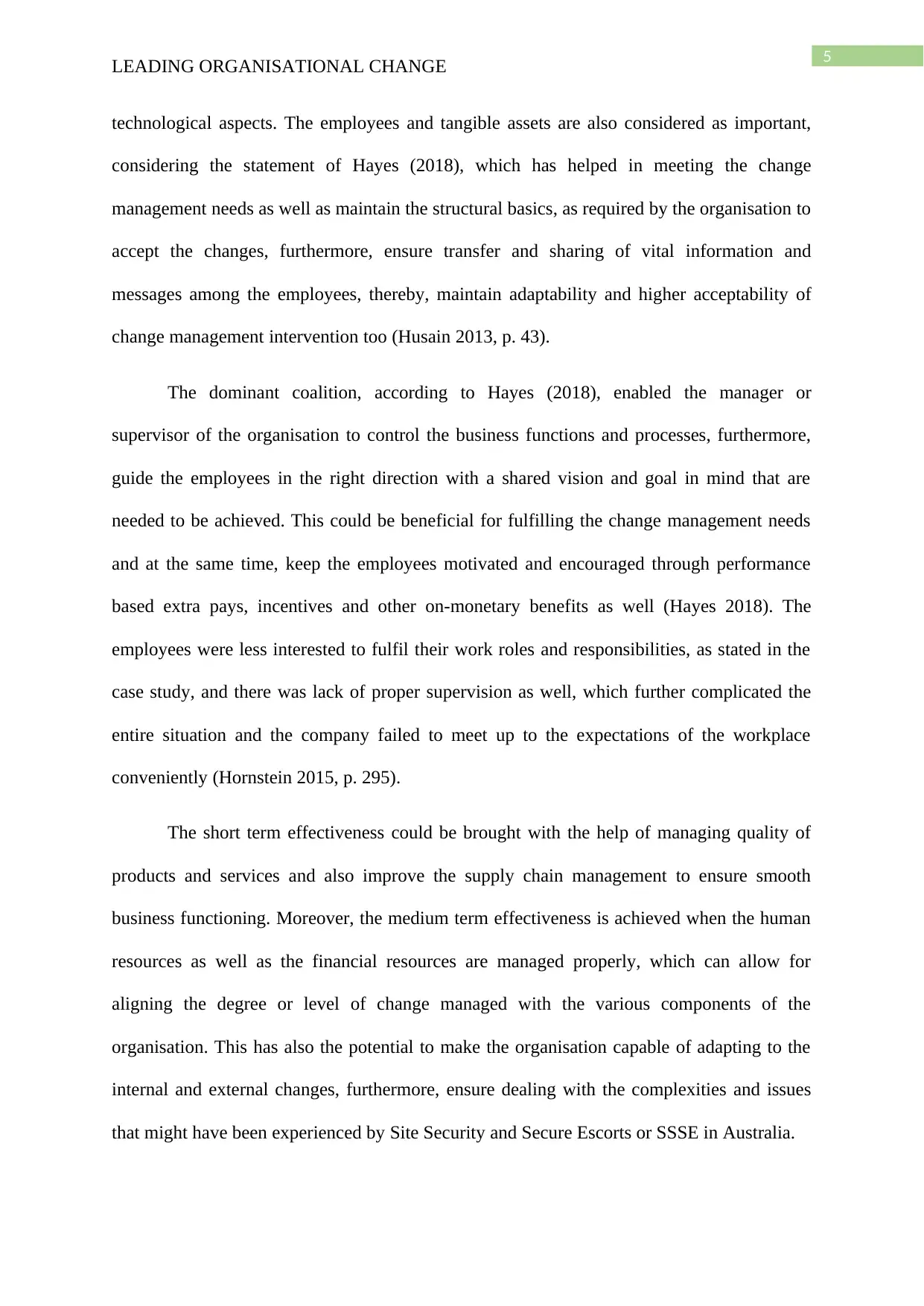
5
LEADING ORGANISATIONAL CHANGE
technological aspects. The employees and tangible assets are also considered as important,
considering the statement of Hayes (2018), which has helped in meeting the change
management needs as well as maintain the structural basics, as required by the organisation to
accept the changes, furthermore, ensure transfer and sharing of vital information and
messages among the employees, thereby, maintain adaptability and higher acceptability of
change management intervention too (Husain 2013, p. 43).
The dominant coalition, according to Hayes (2018), enabled the manager or
supervisor of the organisation to control the business functions and processes, furthermore,
guide the employees in the right direction with a shared vision and goal in mind that are
needed to be achieved. This could be beneficial for fulfilling the change management needs
and at the same time, keep the employees motivated and encouraged through performance
based extra pays, incentives and other on-monetary benefits as well (Hayes 2018). The
employees were less interested to fulfil their work roles and responsibilities, as stated in the
case study, and there was lack of proper supervision as well, which further complicated the
entire situation and the company failed to meet up to the expectations of the workplace
conveniently (Hornstein 2015, p. 295).
The short term effectiveness could be brought with the help of managing quality of
products and services and also improve the supply chain management to ensure smooth
business functioning. Moreover, the medium term effectiveness is achieved when the human
resources as well as the financial resources are managed properly, which can allow for
aligning the degree or level of change managed with the various components of the
organisation. This has also the potential to make the organisation capable of adapting to the
internal and external changes, furthermore, ensure dealing with the complexities and issues
that might have been experienced by Site Security and Secure Escorts or SSSE in Australia.
LEADING ORGANISATIONAL CHANGE
technological aspects. The employees and tangible assets are also considered as important,
considering the statement of Hayes (2018), which has helped in meeting the change
management needs as well as maintain the structural basics, as required by the organisation to
accept the changes, furthermore, ensure transfer and sharing of vital information and
messages among the employees, thereby, maintain adaptability and higher acceptability of
change management intervention too (Husain 2013, p. 43).
The dominant coalition, according to Hayes (2018), enabled the manager or
supervisor of the organisation to control the business functions and processes, furthermore,
guide the employees in the right direction with a shared vision and goal in mind that are
needed to be achieved. This could be beneficial for fulfilling the change management needs
and at the same time, keep the employees motivated and encouraged through performance
based extra pays, incentives and other on-monetary benefits as well (Hayes 2018). The
employees were less interested to fulfil their work roles and responsibilities, as stated in the
case study, and there was lack of proper supervision as well, which further complicated the
entire situation and the company failed to meet up to the expectations of the workplace
conveniently (Hornstein 2015, p. 295).
The short term effectiveness could be brought with the help of managing quality of
products and services and also improve the supply chain management to ensure smooth
business functioning. Moreover, the medium term effectiveness is achieved when the human
resources as well as the financial resources are managed properly, which can allow for
aligning the degree or level of change managed with the various components of the
organisation. This has also the potential to make the organisation capable of adapting to the
internal and external changes, furthermore, ensure dealing with the complexities and issues
that might have been experienced by Site Security and Secure Escorts or SSSE in Australia.
⊘ This is a preview!⊘
Do you want full access?
Subscribe today to unlock all pages.

Trusted by 1+ million students worldwide
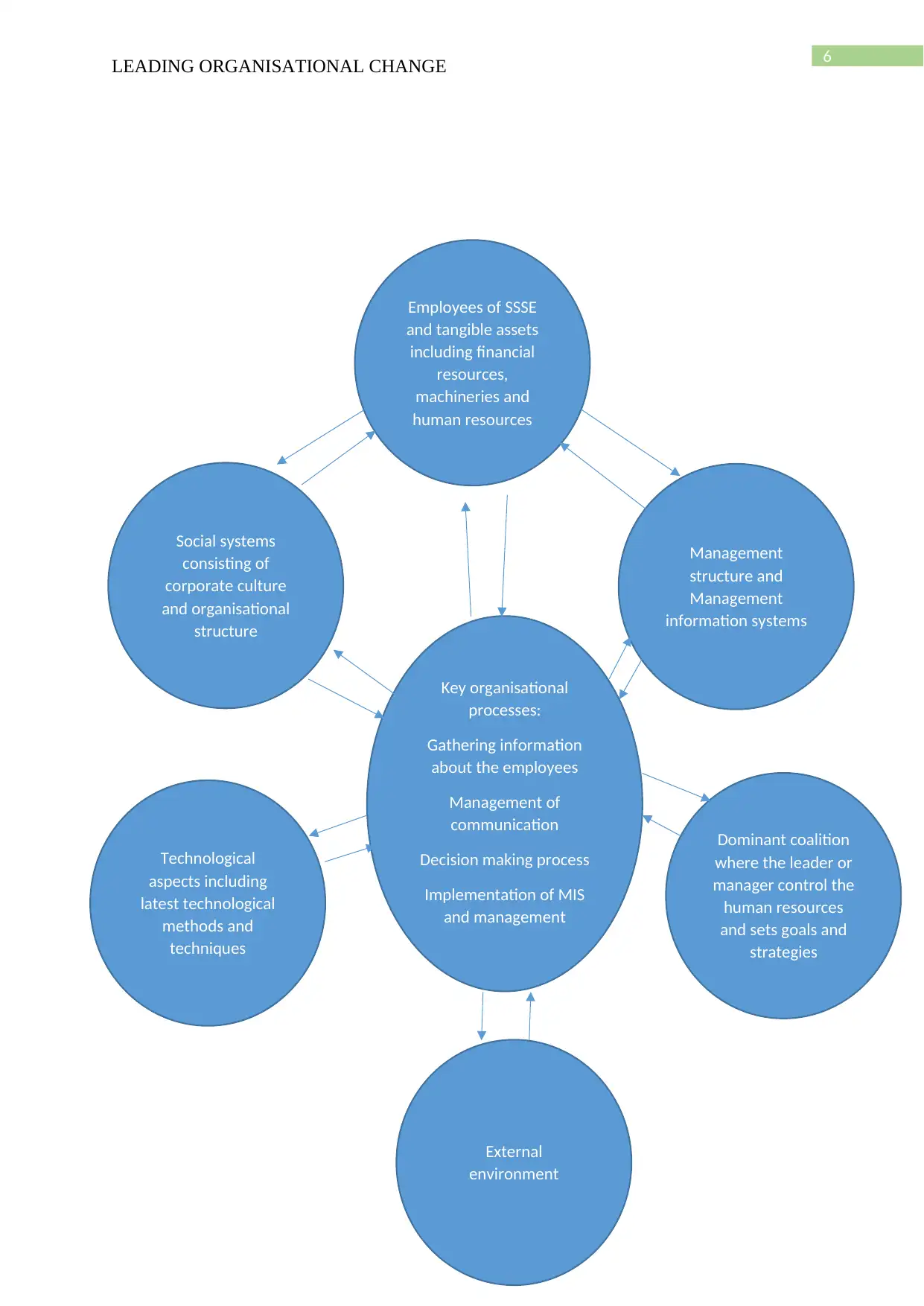
6
LEADING ORGANISATIONAL CHANGE
Key organisational
processes:
Gathering information
about the employees
Management of
communication
Decision making process
Implementation of MIS
and management
structure
Technological
aspects including
latest technological
methods and
techniques
External
environment
Dominant coalition
where the leader or
manager control the
human resources
and sets goals and
strategies
Social systems
consisting of
corporate culture
and organisational
structure
Employees of SSSE
and tangible assets
including financial
resources,
machineries and
human resources
Management
structure and
Management
information systems
LEADING ORGANISATIONAL CHANGE
Key organisational
processes:
Gathering information
about the employees
Management of
communication
Decision making process
Implementation of MIS
and management
structure
Technological
aspects including
latest technological
methods and
techniques
External
environment
Dominant coalition
where the leader or
manager control the
human resources
and sets goals and
strategies
Social systems
consisting of
corporate culture
and organisational
structure
Employees of SSSE
and tangible assets
including financial
resources,
machineries and
human resources
Management
structure and
Management
information systems
Paraphrase This Document
Need a fresh take? Get an instant paraphrase of this document with our AI Paraphraser
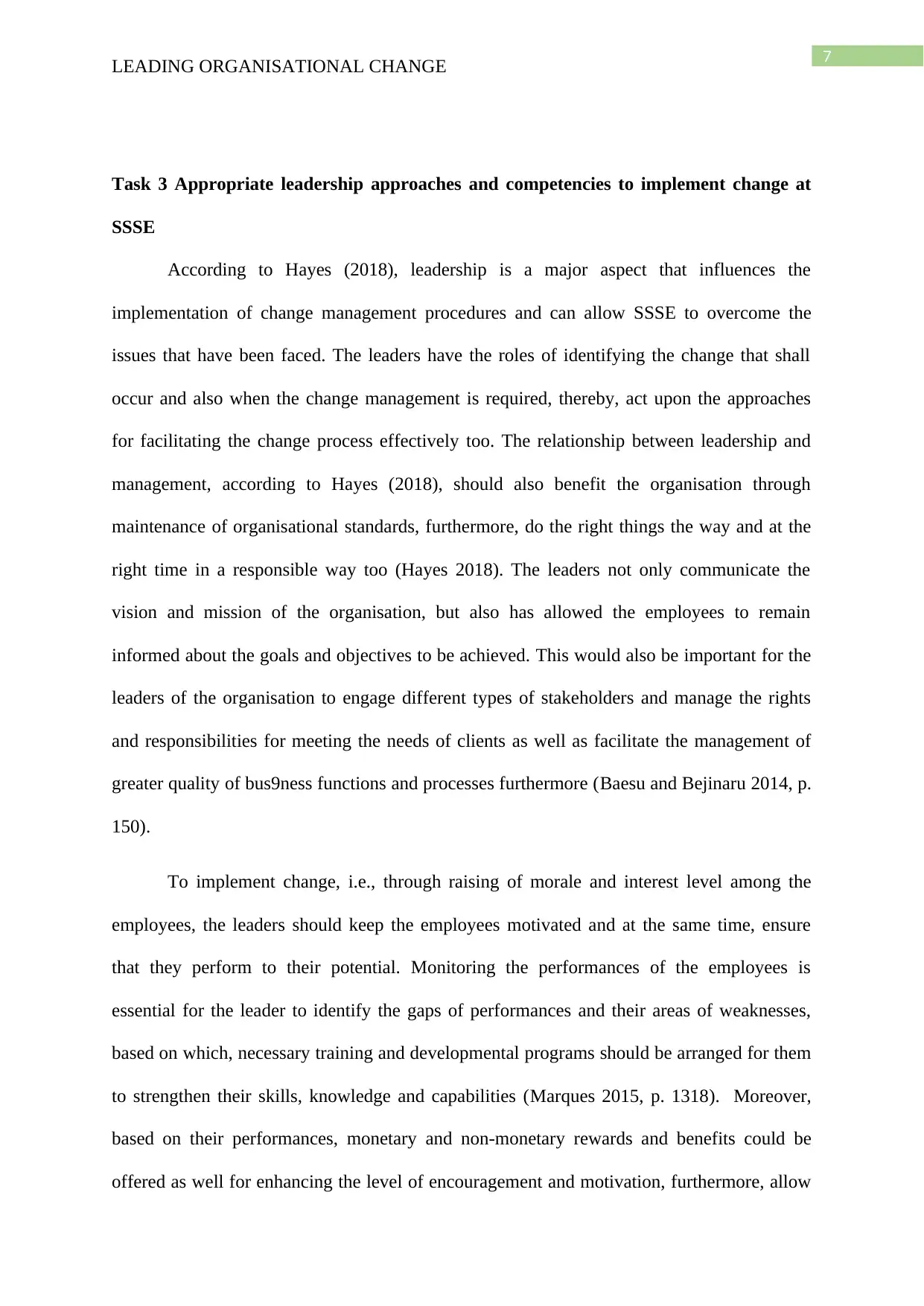
7
LEADING ORGANISATIONAL CHANGE
Task 3 Appropriate leadership approaches and competencies to implement change at
SSSE
According to Hayes (2018), leadership is a major aspect that influences the
implementation of change management procedures and can allow SSSE to overcome the
issues that have been faced. The leaders have the roles of identifying the change that shall
occur and also when the change management is required, thereby, act upon the approaches
for facilitating the change process effectively too. The relationship between leadership and
management, according to Hayes (2018), should also benefit the organisation through
maintenance of organisational standards, furthermore, do the right things the way and at the
right time in a responsible way too (Hayes 2018). The leaders not only communicate the
vision and mission of the organisation, but also has allowed the employees to remain
informed about the goals and objectives to be achieved. This would also be important for the
leaders of the organisation to engage different types of stakeholders and manage the rights
and responsibilities for meeting the needs of clients as well as facilitate the management of
greater quality of bus9ness functions and processes furthermore (Baesu and Bejinaru 2014, p.
150).
To implement change, i.e., through raising of morale and interest level among the
employees, the leaders should keep the employees motivated and at the same time, ensure
that they perform to their potential. Monitoring the performances of the employees is
essential for the leader to identify the gaps of performances and their areas of weaknesses,
based on which, necessary training and developmental programs should be arranged for them
to strengthen their skills, knowledge and capabilities (Marques 2015, p. 1318). Moreover,
based on their performances, monetary and non-monetary rewards and benefits could be
offered as well for enhancing the level of encouragement and motivation, furthermore, allow
LEADING ORGANISATIONAL CHANGE
Task 3 Appropriate leadership approaches and competencies to implement change at
SSSE
According to Hayes (2018), leadership is a major aspect that influences the
implementation of change management procedures and can allow SSSE to overcome the
issues that have been faced. The leaders have the roles of identifying the change that shall
occur and also when the change management is required, thereby, act upon the approaches
for facilitating the change process effectively too. The relationship between leadership and
management, according to Hayes (2018), should also benefit the organisation through
maintenance of organisational standards, furthermore, do the right things the way and at the
right time in a responsible way too (Hayes 2018). The leaders not only communicate the
vision and mission of the organisation, but also has allowed the employees to remain
informed about the goals and objectives to be achieved. This would also be important for the
leaders of the organisation to engage different types of stakeholders and manage the rights
and responsibilities for meeting the needs of clients as well as facilitate the management of
greater quality of bus9ness functions and processes furthermore (Baesu and Bejinaru 2014, p.
150).
To implement change, i.e., through raising of morale and interest level among the
employees, the leaders should keep the employees motivated and at the same time, ensure
that they perform to their potential. Monitoring the performances of the employees is
essential for the leader to identify the gaps of performances and their areas of weaknesses,
based on which, necessary training and developmental programs should be arranged for them
to strengthen their skills, knowledge and capabilities (Marques 2015, p. 1318). Moreover,
based on their performances, monetary and non-monetary rewards and benefits could be
offered as well for enhancing the level of encouragement and motivation, furthermore, allow
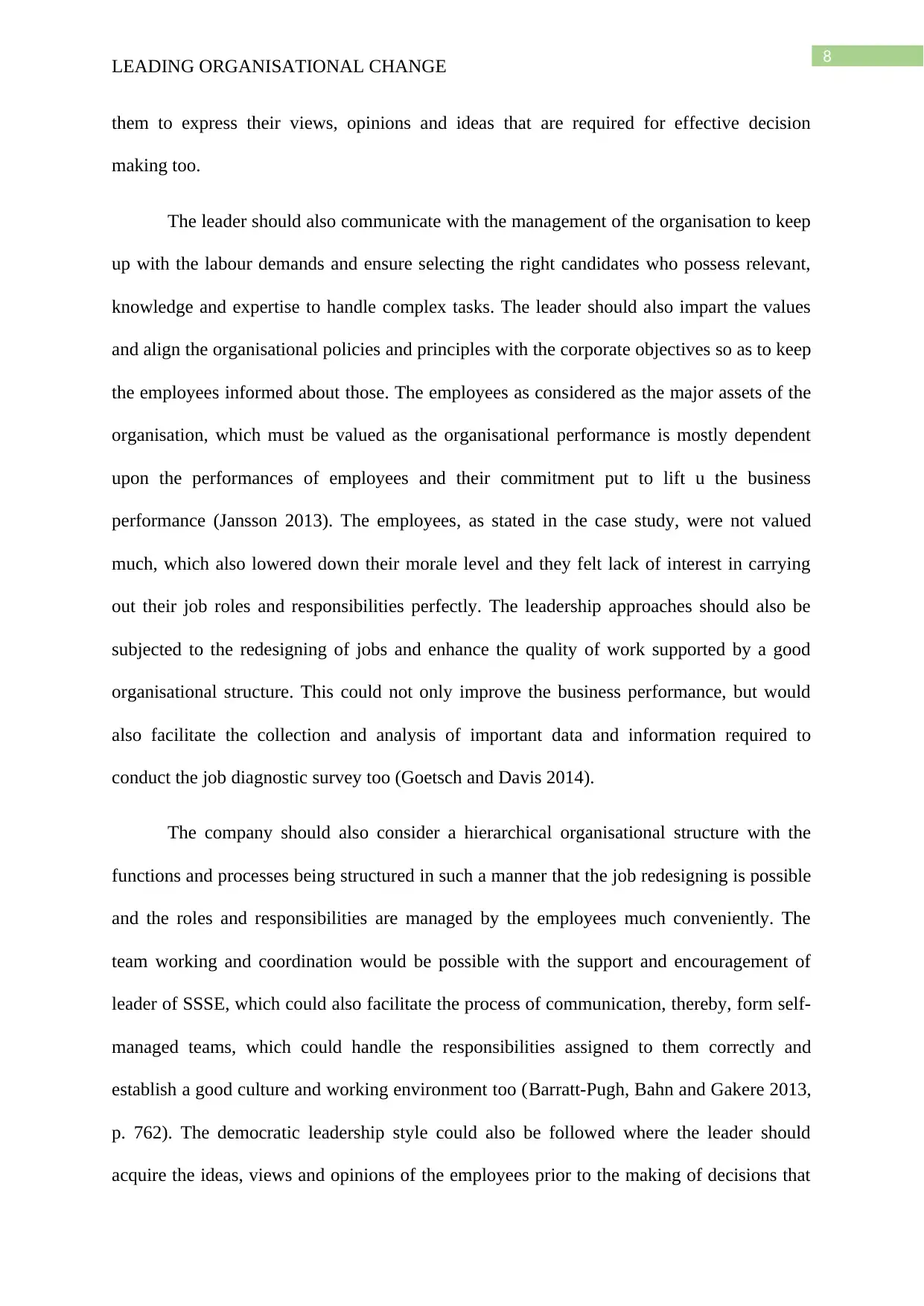
8
LEADING ORGANISATIONAL CHANGE
them to express their views, opinions and ideas that are required for effective decision
making too.
The leader should also communicate with the management of the organisation to keep
up with the labour demands and ensure selecting the right candidates who possess relevant,
knowledge and expertise to handle complex tasks. The leader should also impart the values
and align the organisational policies and principles with the corporate objectives so as to keep
the employees informed about those. The employees as considered as the major assets of the
organisation, which must be valued as the organisational performance is mostly dependent
upon the performances of employees and their commitment put to lift u the business
performance (Jansson 2013). The employees, as stated in the case study, were not valued
much, which also lowered down their morale level and they felt lack of interest in carrying
out their job roles and responsibilities perfectly. The leadership approaches should also be
subjected to the redesigning of jobs and enhance the quality of work supported by a good
organisational structure. This could not only improve the business performance, but would
also facilitate the collection and analysis of important data and information required to
conduct the job diagnostic survey too (Goetsch and Davis 2014).
The company should also consider a hierarchical organisational structure with the
functions and processes being structured in such a manner that the job redesigning is possible
and the roles and responsibilities are managed by the employees much conveniently. The
team working and coordination would be possible with the support and encouragement of
leader of SSSE, which could also facilitate the process of communication, thereby, form self-
managed teams, which could handle the responsibilities assigned to them correctly and
establish a good culture and working environment too (Barratt-Pugh, Bahn and Gakere 2013,
p. 762). The democratic leadership style could also be followed where the leader should
acquire the ideas, views and opinions of the employees prior to the making of decisions that
LEADING ORGANISATIONAL CHANGE
them to express their views, opinions and ideas that are required for effective decision
making too.
The leader should also communicate with the management of the organisation to keep
up with the labour demands and ensure selecting the right candidates who possess relevant,
knowledge and expertise to handle complex tasks. The leader should also impart the values
and align the organisational policies and principles with the corporate objectives so as to keep
the employees informed about those. The employees as considered as the major assets of the
organisation, which must be valued as the organisational performance is mostly dependent
upon the performances of employees and their commitment put to lift u the business
performance (Jansson 2013). The employees, as stated in the case study, were not valued
much, which also lowered down their morale level and they felt lack of interest in carrying
out their job roles and responsibilities perfectly. The leadership approaches should also be
subjected to the redesigning of jobs and enhance the quality of work supported by a good
organisational structure. This could not only improve the business performance, but would
also facilitate the collection and analysis of important data and information required to
conduct the job diagnostic survey too (Goetsch and Davis 2014).
The company should also consider a hierarchical organisational structure with the
functions and processes being structured in such a manner that the job redesigning is possible
and the roles and responsibilities are managed by the employees much conveniently. The
team working and coordination would be possible with the support and encouragement of
leader of SSSE, which could also facilitate the process of communication, thereby, form self-
managed teams, which could handle the responsibilities assigned to them correctly and
establish a good culture and working environment too (Barratt-Pugh, Bahn and Gakere 2013,
p. 762). The democratic leadership style could also be followed where the leader should
acquire the ideas, views and opinions of the employees prior to the making of decisions that
⊘ This is a preview!⊘
Do you want full access?
Subscribe today to unlock all pages.

Trusted by 1+ million students worldwide
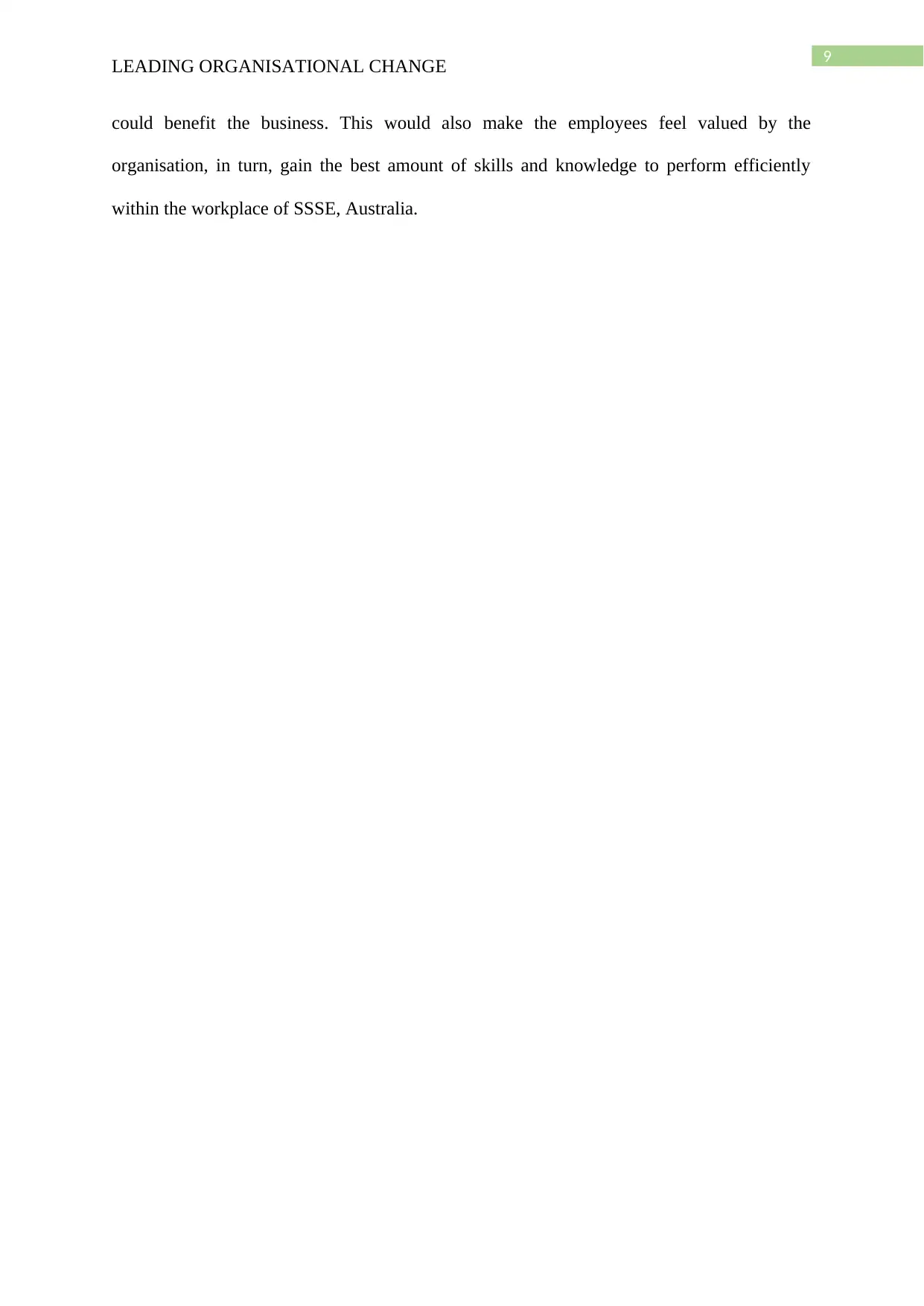
9
LEADING ORGANISATIONAL CHANGE
could benefit the business. This would also make the employees feel valued by the
organisation, in turn, gain the best amount of skills and knowledge to perform efficiently
within the workplace of SSSE, Australia.
LEADING ORGANISATIONAL CHANGE
could benefit the business. This would also make the employees feel valued by the
organisation, in turn, gain the best amount of skills and knowledge to perform efficiently
within the workplace of SSSE, Australia.
Paraphrase This Document
Need a fresh take? Get an instant paraphrase of this document with our AI Paraphraser
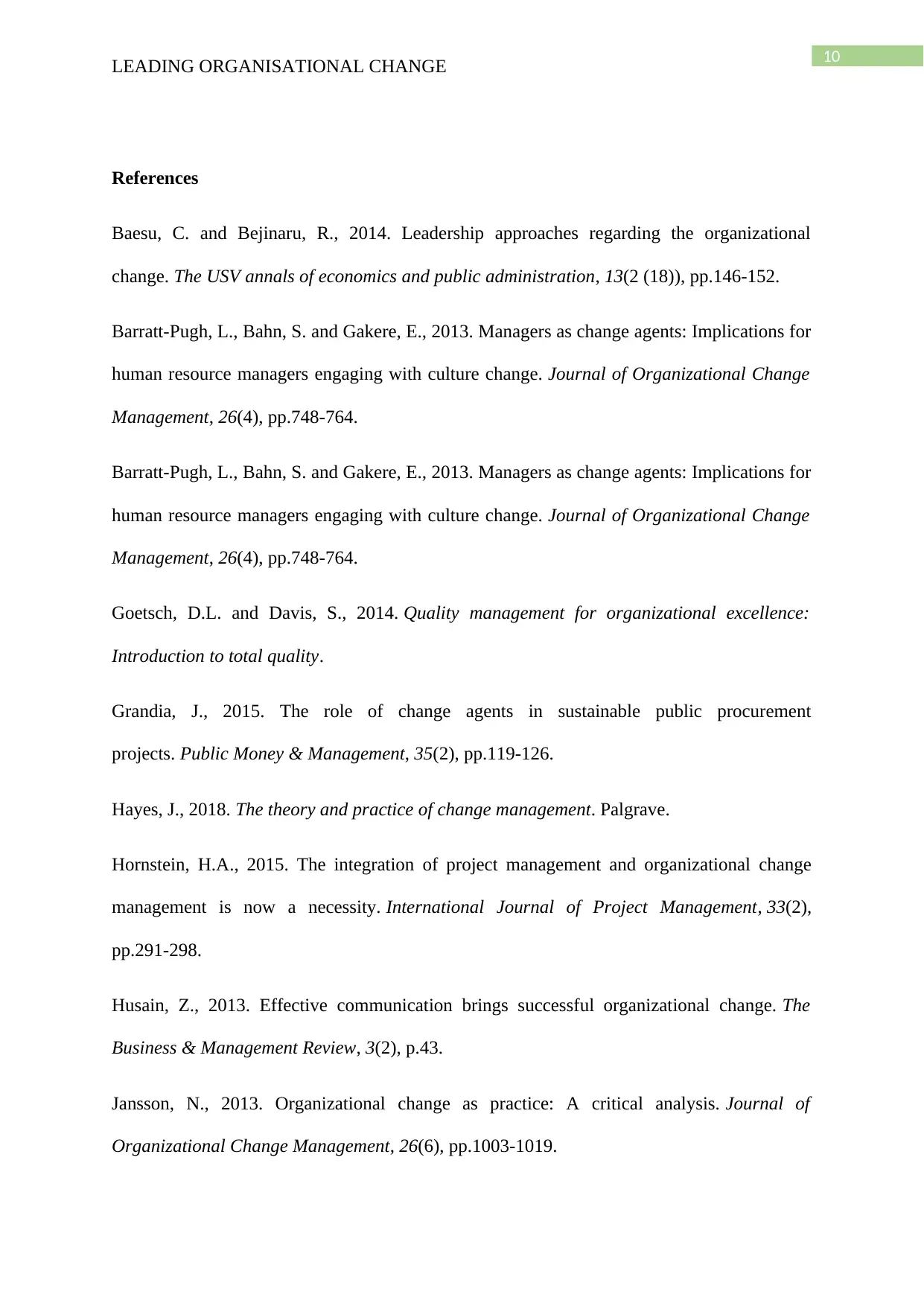
10
LEADING ORGANISATIONAL CHANGE
References
Baesu, C. and Bejinaru, R., 2014. Leadership approaches regarding the organizational
change. The USV annals of economics and public administration, 13(2 (18)), pp.146-152.
Barratt-Pugh, L., Bahn, S. and Gakere, E., 2013. Managers as change agents: Implications for
human resource managers engaging with culture change. Journal of Organizational Change
Management, 26(4), pp.748-764.
Barratt-Pugh, L., Bahn, S. and Gakere, E., 2013. Managers as change agents: Implications for
human resource managers engaging with culture change. Journal of Organizational Change
Management, 26(4), pp.748-764.
Goetsch, D.L. and Davis, S., 2014. Quality management for organizational excellence:
Introduction to total quality.
Grandia, J., 2015. The role of change agents in sustainable public procurement
projects. Public Money & Management, 35(2), pp.119-126.
Hayes, J., 2018. The theory and practice of change management. Palgrave.
Hornstein, H.A., 2015. The integration of project management and organizational change
management is now a necessity. International Journal of Project Management, 33(2),
pp.291-298.
Husain, Z., 2013. Effective communication brings successful organizational change. The
Business & Management Review, 3(2), p.43.
Jansson, N., 2013. Organizational change as practice: A critical analysis. Journal of
Organizational Change Management, 26(6), pp.1003-1019.
LEADING ORGANISATIONAL CHANGE
References
Baesu, C. and Bejinaru, R., 2014. Leadership approaches regarding the organizational
change. The USV annals of economics and public administration, 13(2 (18)), pp.146-152.
Barratt-Pugh, L., Bahn, S. and Gakere, E., 2013. Managers as change agents: Implications for
human resource managers engaging with culture change. Journal of Organizational Change
Management, 26(4), pp.748-764.
Barratt-Pugh, L., Bahn, S. and Gakere, E., 2013. Managers as change agents: Implications for
human resource managers engaging with culture change. Journal of Organizational Change
Management, 26(4), pp.748-764.
Goetsch, D.L. and Davis, S., 2014. Quality management for organizational excellence:
Introduction to total quality.
Grandia, J., 2015. The role of change agents in sustainable public procurement
projects. Public Money & Management, 35(2), pp.119-126.
Hayes, J., 2018. The theory and practice of change management. Palgrave.
Hornstein, H.A., 2015. The integration of project management and organizational change
management is now a necessity. International Journal of Project Management, 33(2),
pp.291-298.
Husain, Z., 2013. Effective communication brings successful organizational change. The
Business & Management Review, 3(2), p.43.
Jansson, N., 2013. Organizational change as practice: A critical analysis. Journal of
Organizational Change Management, 26(6), pp.1003-1019.
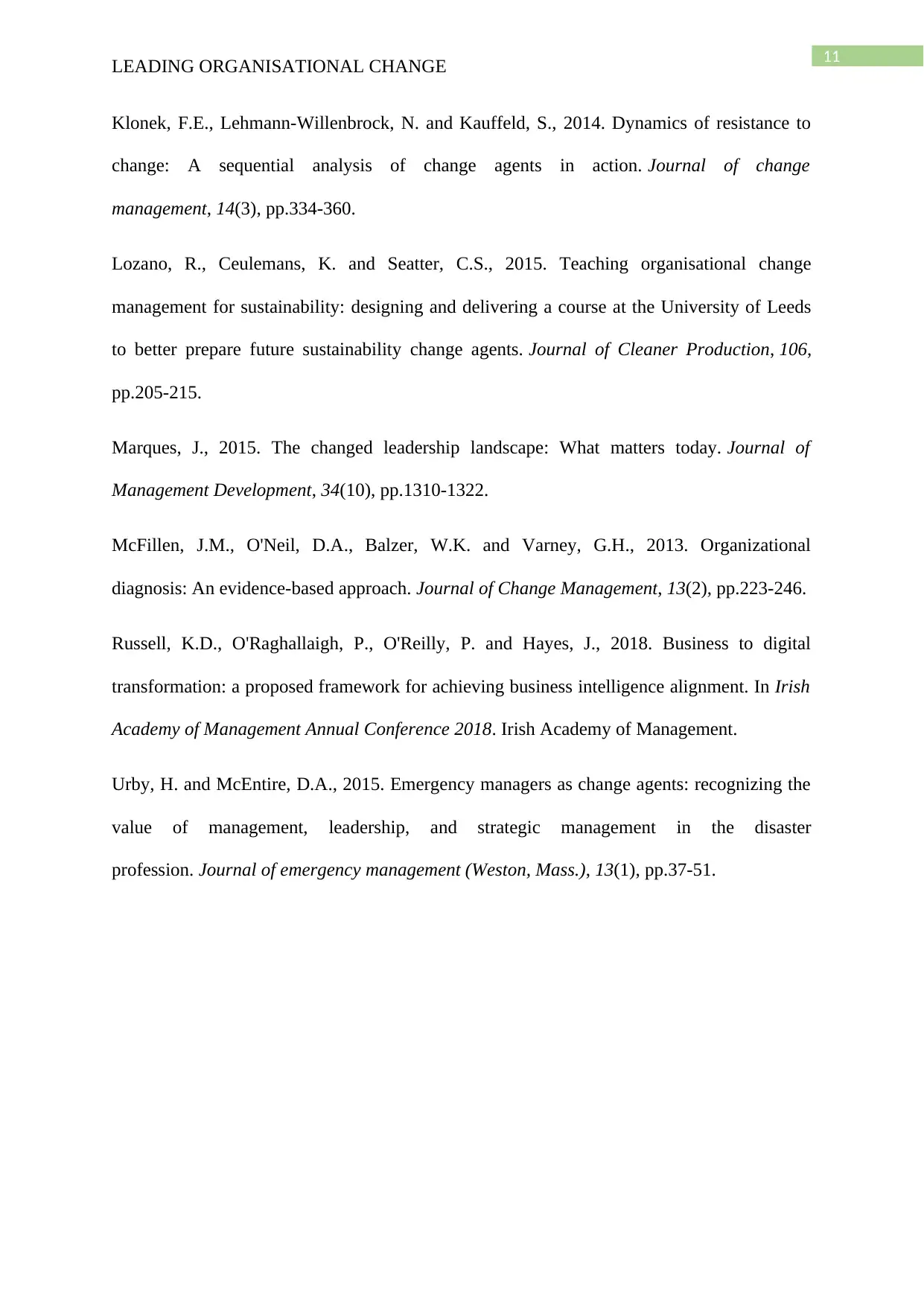
11
LEADING ORGANISATIONAL CHANGE
Klonek, F.E., Lehmann-Willenbrock, N. and Kauffeld, S., 2014. Dynamics of resistance to
change: A sequential analysis of change agents in action. Journal of change
management, 14(3), pp.334-360.
Lozano, R., Ceulemans, K. and Seatter, C.S., 2015. Teaching organisational change
management for sustainability: designing and delivering a course at the University of Leeds
to better prepare future sustainability change agents. Journal of Cleaner Production, 106,
pp.205-215.
Marques, J., 2015. The changed leadership landscape: What matters today. Journal of
Management Development, 34(10), pp.1310-1322.
McFillen, J.M., O'Neil, D.A., Balzer, W.K. and Varney, G.H., 2013. Organizational
diagnosis: An evidence-based approach. Journal of Change Management, 13(2), pp.223-246.
Russell, K.D., O'Raghallaigh, P., O'Reilly, P. and Hayes, J., 2018. Business to digital
transformation: a proposed framework for achieving business intelligence alignment. In Irish
Academy of Management Annual Conference 2018. Irish Academy of Management.
Urby, H. and McEntire, D.A., 2015. Emergency managers as change agents: recognizing the
value of management, leadership, and strategic management in the disaster
profession. Journal of emergency management (Weston, Mass.), 13(1), pp.37-51.
LEADING ORGANISATIONAL CHANGE
Klonek, F.E., Lehmann-Willenbrock, N. and Kauffeld, S., 2014. Dynamics of resistance to
change: A sequential analysis of change agents in action. Journal of change
management, 14(3), pp.334-360.
Lozano, R., Ceulemans, K. and Seatter, C.S., 2015. Teaching organisational change
management for sustainability: designing and delivering a course at the University of Leeds
to better prepare future sustainability change agents. Journal of Cleaner Production, 106,
pp.205-215.
Marques, J., 2015. The changed leadership landscape: What matters today. Journal of
Management Development, 34(10), pp.1310-1322.
McFillen, J.M., O'Neil, D.A., Balzer, W.K. and Varney, G.H., 2013. Organizational
diagnosis: An evidence-based approach. Journal of Change Management, 13(2), pp.223-246.
Russell, K.D., O'Raghallaigh, P., O'Reilly, P. and Hayes, J., 2018. Business to digital
transformation: a proposed framework for achieving business intelligence alignment. In Irish
Academy of Management Annual Conference 2018. Irish Academy of Management.
Urby, H. and McEntire, D.A., 2015. Emergency managers as change agents: recognizing the
value of management, leadership, and strategic management in the disaster
profession. Journal of emergency management (Weston, Mass.), 13(1), pp.37-51.
⊘ This is a preview!⊘
Do you want full access?
Subscribe today to unlock all pages.

Trusted by 1+ million students worldwide
1 out of 12
Related Documents
Your All-in-One AI-Powered Toolkit for Academic Success.
+13062052269
info@desklib.com
Available 24*7 on WhatsApp / Email
![[object Object]](/_next/static/media/star-bottom.7253800d.svg)
Unlock your academic potential
Copyright © 2020–2025 A2Z Services. All Rights Reserved. Developed and managed by ZUCOL.





